
A tornado is a violently rotating column of air that is in contact with both the surface of the Earth and a cumulonimbus cloud or, in rare cases, the base of a cumulus cloud. It is often referred to as a twister, whirlwind or cyclone, although the word cyclone is used in meteorology to name a weather system with a low-pressure area in the center around which, from an observer looking down toward the surface of the Earth, winds blow counterclockwise in the Northern Hemisphere and clockwise in the Southern. Tornadoes come in many shapes and sizes, and they are often visible in the form of a condensation funnel originating from the base of a cumulonimbus cloud, with a cloud of rotating debris and dust beneath it. Most tornadoes have wind speeds less than 180 kilometers per hour, are about 80 meters across, and travel several kilometers before dissipating. The most extreme tornadoes can attain wind speeds of more than 480 kilometers per hour (300 mph), are more than 3 kilometers (2 mi) in diameter, and stay on the ground for more than 100 km (62 mi).

El Reno is a city in and county seat of Canadian County, Oklahoma, United States. As of the 2020 census, the city population was 16,989, marking a change of 1.55% from 16,729, recorded in the 2010 census. The city was begun shortly after the 1889 land rush and named for the nearby Fort Reno. It is located in Central Oklahoma, about 25 miles (40 km) west of downtown Oklahoma City.
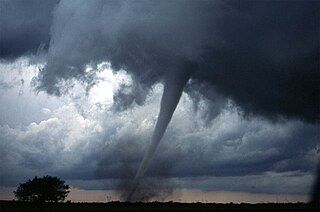
The 1999 Oklahoma tornado outbreak was a significant tornado outbreak that affected much of the Central and parts of the Eastern United States, with the highest record-breaking wind speeds of 301 ± 20 mph (484 ± 32 km/h). During this week-long event, 154 tornadoes touched down. More than half of them were on May 3 and 4 when activity reached its peak over Oklahoma, Kansas, Nebraska, Texas, and Arkansas.

This article lists various tornado records. The most "extreme" tornado in recorded history was the Tri-State tornado, which spread through parts of Missouri, Illinois, and Indiana on March 18, 1925. It is considered an F5 on the Fujita Scale, even though tornadoes were not ranked on any scale at the time. It holds records for longest path length at 219 miles (352 km), longest duration at about 3+1⁄2 hours, and it held the fastest forward speed for a significant tornado at 73 mph (117 km/h) anywhere on Earth until 2021. In addition, it is the deadliest single tornado in United States history with 695 fatalities. It was also the third most costly tornado in history at the time, but has been surpassed by several others when non-normalized. When costs are normalized for wealth and inflation, it still ranks third today.

A multiple-vortex tornado is a tornado that contains several vortices revolving around, inside of, and as part of the main vortex. The only times multiple vortices may be visible are when the tornado is first forming or when condensation and debris are balanced such that subvortices are apparent without being obscured. They can add over 100 mph to the ground-relative wind in a tornado circulation and are responsible for most cases where narrow arcs of extreme destruction lie right next to weak damage within tornado paths.
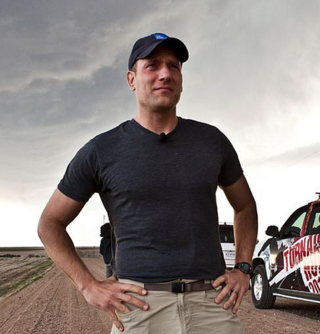
Michael Bettes is an American television meteorologist and storm chaser who works for The Weather Channel in Atlanta, Georgia. He was a co-host of AMHQ: America's Morning Headquarters. He hosts Weather Underground TV. Bettes has been an on-camera meteorologist for TWC since 2003, and is also an occasional fill-in weather anchor on The Today Show.

Storm Chasers is an American documentary reality television series that premiered on October 17, 2007, on the Discovery Channel. Produced by Original Media, the program follows several teams of storm chasers as they attempt to intercept tornadoes in Tornado Alley in the United States. The show was canceled at the end of its 5th season by Discovery Communications on January 21, 2012.

The Verification of the Origins of Rotation in Tornadoes Experiment are field experiments that study tornadoes. VORTEX1 was the first time scientists completely researched the entire evolution of a tornado with an array of instrumentation, enabling a greater understanding of the processes involved with tornadogenesis. A violent tornado near Union City, Oklahoma was documented in its entirety by chasers of the Tornado Intercept Project (TIP) in 1973. Their visual observations led to advancement in understanding of tornado structure and life cycles.

TWISTEX was a tornado research experiment that was founded and led by Tim Samaras of Bennett, Colorado, US, that ended in the deaths of three researchers in the 2013 El Reno tornado. The experiment announced in 2015 that there were some plans for future operations, but no additional information has been announced since.

The 1999 Bridge Creek–Moore tornado was a large and exceptionally powerful F5 tornado in which the highest wind speeds ever measured globally were recorded at 301 ± 20 miles per hour (484 ± 32 km/h) by a Doppler on Wheels (DOW) radar. Considered the strongest tornado ever recorded to have affected the metropolitan area, the tornado while near peak intensity devastated southern portions of Oklahoma City, Oklahoma, United States, along with surrounding suburbs and towns to the south and southwest of the city during the early evening of Monday, May 3, 1999. Parts of Bridge Creek were rendered unrecognizable. The tornado covered 38 miles (61 km) during its 85-minute existence, destroying thousands of homes, killing 36 people, and leaving US$1 billion in damage, ranking it as the fifth-costliest on record not accounting for inflation. Its severity prompted the first-ever use of the tornado emergency statement by the National Weather Service.

This page documents the tornadoes and tornado outbreaks of 2011. Extremely destructive tornadoes form most frequently in the United States, Bangladesh, Brazil and Eastern India, but they can occur almost anywhere under the right conditions. Tornadoes also appear regularly in neighboring southern Canada during the Northern Hemisphere's summer season, and somewhat regularly in Europe, Asia, and Australia.

The SRV Dominator is the name given to a series of vehicles used for Reed Timmer, as featured on the Discovery Channel series Storm Chasers. In April 2013, Timmer, designer and operator of all three Dominator vehicles, joined KFOR-TV's 4WARN Storm Team, all three vehicles collectively referred to by the station as "Dominator 4".
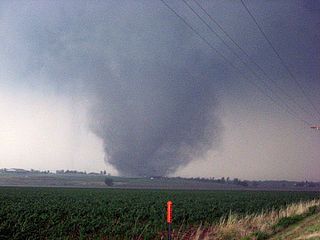
From May 21 to May 26, 2011, one of the largest tornado outbreaks on record affected the Midwestern and Southern regions of the United States. A six-day tornado outbreak sequence, most of the tornadoes developed in a corridor from Lake Superior southwest to central Texas, while isolated tornadoes occurred in other areas. An especially destructive EF5 tornado destroyed one-third of Joplin, Missouri, resulting in 158 deaths and over 1,000 injuries. The Joplin tornado was the deadliest in the United States since April 9, 1947, when an intense tornado killed 181 in the Woodward, Oklahoma, area. Tornado-related deaths also occurred in Arkansas, Kansas, Minnesota, and Oklahoma. Overall, the tornado outbreak resulted in 186 deaths, 8 of those non-tornadic, making it second only to the 2011 Super Outbreak as the deadliest since 1974. It was the second costliest tornado outbreak in United States history behind that same April 2011 outbreak, with insured damage estimated at $4–7 billion.

During the late afternoon and early evening of April 27, 2011, a violent, high-end EF4 multiple-vortex tornado destroyed portions of Tuscaloosa and Birmingham, Alabama, as well as smaller communities and rural areas between the two cities. It is one of the costliest tornadoes on record, and was one of the 360 tornadoes in the 2011 Super Outbreak, the largest tornado outbreak in United States history. The tornado reached a maximum path width of 1.5 miles (2.4 km) during its track through Tuscaloosa, and again when it crossed I-65 north of Birmingham, attaining estimated wind speeds of 190 mph (310 km/h) shortly after passing through the city. It then went on to impact parts of Birmingham at high-end EF4 intensity before dissipating. This was the third tornado to strike the city of Tuscaloosa in the past decade, and the second in two weeks.

On the afternoon of May 20, 2013, a large and extremely violent EF5 tornado ravaged Moore, Oklahoma, and adjacent areas, with peak winds estimated at 210 miles per hour (340 km/h), killing 24 people and injuring 212 others. The tornado was part of a larger weather system that had produced several other tornadoes across the Great Plains over the previous two days, including five that struck portions of Central Oklahoma the day prior on May 19.
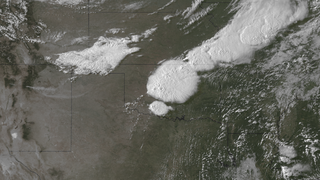
A prolonged and widespread tornado outbreak sequence affected a large portion of the United States in late-May 2013 and early-June 2013. The outbreak was the result of a slow-moving but powerful storm system that produced several strong tornadoes across the Great Plains states, especially in Kansas and Oklahoma. Other strong tornadoes caused severe damage in Nebraska, Missouri, Illinois, and Michigan. The outbreak extended as far east as Upstate New York. 27 fatalities were reported in total, with nine resulting from tornadoes.

Timothy Michael Samaras was an American engineer and storm chaser best known for his field research on tornadoes and time on the Discovery Channel show Storm Chasers. He died in the 2013 El Reno tornado.
The following is a glossary of tornado terms. It includes scientific as well as selected informal terminology.

During the afternoon of April 27, 2011, a violent EF5 tornado touched down in eastern Mississippi, killing three people. Part of the historic 2011 Super Outbreak, the largest tornado outbreak on record, this was the first of four EF5 tornadoes to touch down that day and the first such storm in Mississippi since the 1966 Candlestick Park tornado. While on the ground for 30 minutes, it traveled along a 28.28-mile (45.51 km) path through four counties, leaving behind three deaths, eight injuries, and $1.1 million in damage.
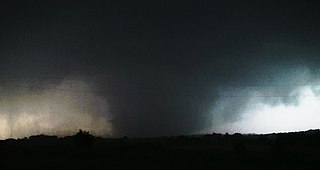
The 2011 El Reno–Piedmont tornado was a long-tracked, deadly EF5 tornado that struck central Oklahoma on the evening of May 24, 2011. The tornado impacted areas near or within the communities of El Reno, Piedmont, and Guthrie, killing nine and injuring 181. After producing incredible damage in several locations along a path of over 60 mi (97 km), the El Reno–Piedmont tornado was given a rating of EF5, the highest category on the Enhanced Fujita scale, and was found by mobile radar to have possessed possible wind speeds of up to 295 mph (475 km/h). It was the first tornado rated EF5 or F5 to strike Oklahoma since the 1999 Bridge Creek–Moore tornado.




























